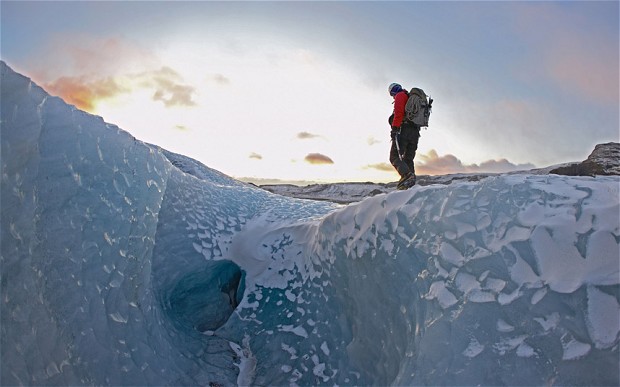“Walking on water is easier than it sounds. First you need strong crampons and a trusty guide, and it’s best to have an ice axe to be on the safe side. Then you step gingerly onto the water – after it has frozen over centuries into a glacier – and enter another world of astonishing power and beauty.”
In his article about hiking Iceland’s glaciers, The Daily Telegraph reporter Gavin Bell described the breathtaking experience in great detail.
“Forget all you may know about the smooth inclines of ice caps in alpine ski resorts. Arctic glaciers are rivers of ice that rise and fall and tumble in mad confusion, rearing into cliffs and plunging into hidden crevasses,” he writes.
Bell hiked glaciers with Arctic Adventures, a company that offers brief ice walking excursions for beginners. As they drove across the south coast, guide Ingvar Kristjansson described Iceland’s belief in trolls and the huldufolk (hidden people) who inhabit a parallel spiritual world. According to Bell, the trolls are easier to spot than the huldufolk, having been struck by sunshine and turned into bizarre lava formations.
“Our first view of Solheimajökull is from beyond a car park at the end of a gravel road. It looks like a tumultuous sea, frozen in the act of crashing on shore. At its base, wind and water have carved a glistening ice cavern that looks fragile under tidal waves of ice. We don’t go into it.
Our first lesson is on fitting and using crampons and ice axes on a small ice slope. “Walk like a duck or a cowboy,” Ingvar suggests for hiking uphill with splayed feet. When new-found skills for descending and traversing are deemed satisfactory, we set off with a reassuring scrunch of crampon spikes gripping the ice.
A recent storm has deposited a layer of snow that conceals crevasses and water-carrying tunnels. We are instructed not to walk on untouched snow, to follow our guide’s footsteps, and to stay clear of any places he marks in the snow with an X.
It is a slow and easy ascent into a frozen world that is moving imperceptibly beneath our feet, and gradually disappearing. The glacier is receding at between 30 and 50 metres a year, leaving an ugly scar of geological rubble, and at the present rate of global warming it is estimated the last Icelandic glacier will melt in 200 years.
But for now, we are experiencing the same icescapes that draw adventurers to train for polar expeditions. They can spend weeks on Icelandic ice caps testing their equipment – and themselves; we have only a couple of hours, but the indelible impressions are the same.”
Click here to read “Glacier Hiking in Iceland” from The Daily Telegraph.


Comments
article Next
article